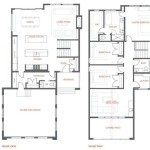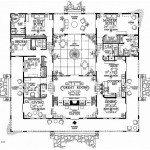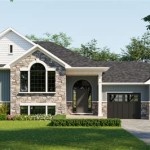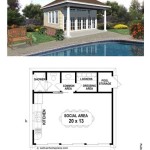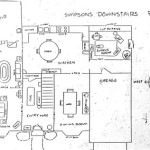Floor Plans With Separate Garages: Design Considerations and Benefits
Floor plans with separate garages are a design choice gaining popularity for their aesthetic appeal, practical advantages, and potential for increased property value. These floor plans detach the garage from the main house structure, offering a distinct architectural statement and functional segregation of space. This article will explore the various aspects of designing floor plans with separate garages, highlighting the benefits and considerations involved in opting for this architectural style.
Architectural Styles and Aesthetic Appeal
The decision to incorporate a separate garage into a floor plan significantly impacts the overall aesthetic of a property. Detached garages offer greater flexibility in architectural design compared to integrated garages. They can be designed to complement the main house's style or to stand as a distinct architectural feature. This allows for a more visually interesting property with enhanced curb appeal. For example, a traditional farmhouse-style house might benefit from a detached garage designed to mimic a barn, complete with sliding barn doors and rustic siding. Conversely, a more contemporary home could pair with a minimalist, modern detached garage featuring clean lines and large windows.
Beyond stylistic considerations, the placement of a detached garage contributes to the visual flow of the property. Separating the garage allows for a clearer definition of the home's footprint, often resulting in a more balanced and visually appealing composition. Landscaping can further enhance this effect, using pathways, gardens, or strategically placed trees to connect the house and detached garage in a cohesive and aesthetically pleasing manner. The separation also allows for a dedicated front facade of the main house, unencumbered by garage doors, leading to a more welcoming and inviting entrance.
The visual appeal of a detached garage can also be enhanced by its roof design. Gable roofs, hip roofs, or even flat roofs can be employed, depending on the desired aesthetic. The roofing material can be matched to the main house or chosen to provide contrast and visual interest. Additionally, features such as dormers, cupolas, or decorative vents can be added to further customize the garage's appearance and enhance its architectural character.
Functional Advantages and Space Utilization
Floor plans with separate garages offer distinct functional advantages, primarily related to noise reduction, odor control, and expanded living space options. A detached garage effectively isolates noise generated from vehicles, power tools, or other garage-related activities from the main living areas. This is particularly beneficial for households with young children, light sleepers, or those who value a quiet and peaceful home environment. Similarly, a detached garage helps to contain odors associated with vehicles, gasoline, oil, or other chemicals commonly stored in garages, preventing them from permeating the living space.
The separation of the garage opens up possibilities for alternative uses of space within the main house. Without the need for an attached garage, the floor plan can be redesigned to maximize living space, potentially creating larger rooms, additional bedrooms, or dedicated home office areas. This is especially valuable on smaller lots where maximizing square footage is a priority. Furthermore, the space occupied by the garage can be repurposed for other features, such as a mudroom, laundry room, or additional storage space, enhancing the functionality and convenience of the home.
Detached garages often provide an opportunity for additional functional uses beyond vehicle storage. The space above the garage can be utilized as a guest suite, a home office, a recreational room, or even a rental apartment, providing extra income potential. This added flexibility makes detached garages a valuable asset for homeowners seeking to maximize the utility of their property. The separation of this secondary living space also ensures a degree of privacy for both the homeowner and the occupants of the garage apartment, fostering a comfortable and independent living arrangement.
Cost Considerations and Construction Implications
The decision to build a separate garage has significant cost implications that must be carefully considered. The construction of a detached garage typically involves higher initial costs compared to building an attached garage. This is due to the need for a separate foundation, walls, roof, and utilities, as well as additional costs associated with connecting the garage to existing utility lines. The cost will also vary depending on the chosen building materials, size, and complexity of the design. Thorough budgeting and planning are essential to ensure that the project remains within financial constraints.
Site access and lot size play a crucial role in the feasibility and cost of constructing a detached garage. Limited site access can increase construction costs due to the difficulty of maneuvering equipment and materials. Smaller lots may present challenges in terms of complying with zoning regulations regarding setbacks and building height restrictions. A professional site survey and consultation with a qualified contractor are recommended to assess the suitability of the lot for a detached garage and to identify any potential challenges or limitations.
Permitting and regulatory compliance are essential aspects of building a detached garage. Local building codes and zoning ordinances dictate specific requirements for detached structures, including setbacks from property lines, height restrictions, and parking requirements. Obtaining the necessary permits and adhering to all applicable regulations is crucial to avoid potential fines or legal complications. Engaging a licensed architect or contractor familiar with local building codes can help ensure that the project complies with all requirements and that the permitting process is completed smoothly.
The long-term cost benefits should also be factored into the decision-making process. While the initial construction costs may be higher, a detached garage can potentially increase property value, leading to a higher return on investment. Furthermore, the added functionality and flexibility offered by a detached garage, such as the potential for rental income or additional living space, can offset the initial costs over time. A comprehensive cost-benefit analysis is recommended to determine the financial viability of building a detached garage and to assess its potential long-term value.

House Plans With Detached Garage

Modern Farmhouse Plan With Two Separate Garages 62798dj Architectural Designs House Plans

Affordable Transitional Style House Plan 7789 Jetson

One Level Coastal House Plan With Split Garage Layout 66390jmd Architectural Designs Plans

Easy Detached Garage Floor Plans Now

3 Car Detached Garage Plan With Guest Room Bath And Loft 68706vr Architectural Designs House Plans

12 Simple 2 Bedroom House Plans With Garages Houseplans Blog Com

House With Detached Garage 20x40 Plan 2 Bedrooms

Hill Country House Plan With Split Garage 333007jhb Architectural Designs Plans

Plan 500018vv Quintessential American Farmhouse With Detached Garage And Breezeway 3134 Sq Ft

